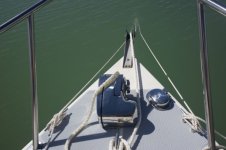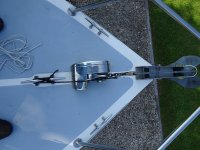extendable boat hooks, with one or two of the little dimples that pop into holes--far better than a "twist lock". For any C Dory beyond a 16,
two boat hooks both with interchangeable end fittings. I like the ones which have several knobs and a curl back. There are many accessories for putting lines over pilings etc. I have used the 14' non-extendable wooden poles with fixed knobbed and sharp spike bronze end fittings on my larger vessels where I could secure them on top of a pilot hose--and will not fail under load
Chests: Yeti or similar are good. RTIC some of the Coleman and Igloo are very good, some not so good., We have an older "Outer Banks" which is as good as when we bought it from Boat US store 20 or so years ago.
We also have used the Danfoss/SEPCO compressor chests for overhead 50 years. I had very bad luck with what are now Dometic. I use Norcold, Engle, ARB, Whynter (two cambers different temperatuers) ICECO, There is one which I believe Jody uses which is also very good. Lots of new Chinese units on the market.
Below
Is a very comprehensive review on the C Brat site
In 2020
Jody Kidd linked to this article, and recommended the top one in this link The National Luna 52 qt Legacy. It has always had high ratings, however it was hard to get in the US.
Another review
Any dinghy should be registered--even if you only have a trolling motor on it. I also put the "tender to" Yacht XXXX on the aft side. There is a disadvantage to that, if someone wants to rob your boat...they know when you are ashore. Obviously kayaks, paddle boards, et do not have to be registered.
Sorry to strongly disagree with Tom Hurby, unless what he describes is different that what I know of. A 3/8" bungee with hooks, could become a dangerous item, under heavy load and the hooks give way or straighten. One should never use a "wire" open hook in anchoring gear, same with carabiners, unless rated at the SWL equal to or greater than the Rope (Wichard has some, which are stamped with SWL). The same holds true for anchoring D or Bow shackles. I use lighter lines, such 5 /16 nylon US made line. If Tom disagrees, then he has never been in anchoring conditions, even on the C Dory, where there were very high winds. Your boat and even your life may depend on your anchoring gear--never compromise. Never use the immitation Danforths--use Danforth HT, or. West Marine performance, or Fortress (Guardian in some cases). Use US premium nylon line and quality thimbles (Usually I use SS) I use my own splices, but I have been splicing rope and cable for over 75 years.
The photo below is 5/16 with 1/2" Brait. If you use "chain hooks" the SS plate with holes for proper D shackles and the snubber lines having an eye splice with proper thimble. These lines are using a double rolling hitch

I normally do not use a float on an anchor line. In areas where the anchor might get hung up, I might use a float, with a line attached to the crown of the anchor. I did this once at Santa Cruz Island (Southern California);an abalone boat went right over it, and wound the line up into his prop. I also have had neophyte boaters try and pick it up when anchoring at Catalina, two harbors. The bow anchor would be in 100 feet of water, and the stern anchor in much shoaler water. I always carried several spare anchors and rode to use to moor boaters like that--give them a few instructions and then anchor for them with my gear and dinghy. Much better than to wake up at night with another boat bumping into you! Many times these new folks go to dinner and return to find their boat "gone". They just drag anchor.
The only time I have used floating line to moor my boat was when stern too Rocks and Trees--Even in Europe I use Nylon, because floating was not the convention as it is in the USA and Canada. When I tie to rocks or trees, I use chain, and a proper shackle for the rode, and the chain around the rope or tree. I carry a several lengths of 1 1/2" or 2" old fire hose to protect the tree's bark. Fire stations regularly replace the hoses, especially if damaged. I have fireman friends who get this for me. I do carry red plastic floats attached the line, if it is not clear where it enters the water and is shoal, so a sailboat does not trip it with their keel.
Once when anchored in Turkey a flotilla of 26' charter sailboats anchored to windward of me, and went off to diner, without properly set their anchors (very common) The next morning when we got ready to leave, all of these boats, except the leader; had drug their anchors, and which were tangled in my 200 feet of anchor chain. As we came to each boat, we would rap on the deck with the bronze knob tip of the boat hook as we were to pull their anchor off our chain, and let their boat drift with the anchor down. They came on deck, obviously hung over..Not having a clue why their anchors were on my chain.



